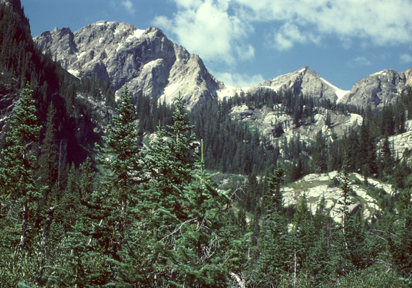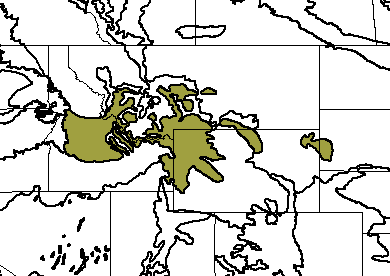
Grand Tetons National Park, Wyoming (c) 2005 James H. Bassett
Bioimages home (click on an image to enlarge)
view
this page in its intended navigation context
South Central Rockies forests
(WWF
ecoregion NA0528)

Grand Tetons National Park, Wyoming
(c)
2005 James H.
Bassett

Source of bioregions data:
Olson, D. M. and
E. Dinerstein. The Global 200: Priority ecoregions for global conservation. (PDF
file) Annals of the Missouri Botanical Garden 89:125-126.
Distinctiveness (1=highest,4=lowest): 3 (bioregionally
important)
The abrupt elevation changes in this region create a variety of vegetation zones.
Unique communities are associated with the geothermal features of Yellowstone
National Park.*
Conservation Status (1=most endangered, 5=most
intact): 4 (relatively stable)
The mountain ranges are relatively intact, although disturbed by mining,
logging, and fire suppression. Development in the valleys has contributed
to fragmentation of the blocks of protected areas.*
 | Pseudotsuga menziesii | (Douglas fir) |
 | Picea engelmannii | (Engelmann spruce) |
 | Abies lasiocarpa | (subalpine fir) |
 | Pinus contorta | (lodgepole pine) |
 Pinus
albicans (whitebark pine)
Pinus
albicans (whitebark pine)
Associated habitats
View habitats of the northern Rockies at ECOS Guide to the Ecology of the Northern Rockies.
Yellowstone National Park, Wyoming

Lower Yellowstone Falls, Grand Canyon of the Yellowstone
(c)
2005 James H.
Bassett
hires


The geothermal features create unique microbial communities adapted to high
temperatures. Taq polymerase, the critical ingredient for the
revolutionary molecular biological technique of PCR, was isolated from the
microorganism Thermophilus aquilis living in a Yellowstone hot spring
(c)
2005 James H.
Bassett
hires
hires

Before the mid-1970s, bears were routinely fed in
the park, creating "bear jams" and dangerous encounters between the bears and
humans.
(c)
2005 James H.
Bassett
hires

Although the large fires in the park during the
1990s were perceived by much of the public as destructive, they allowed for the
recovery of fire-adapted species that suffered during decades of fire
suppression in the park. (c)
2005 Scott and
Ruth Bassett
hires
Grand Tetons National Park, Wyoming



left: low elevation forest, center: treeline, right: alpine tundra
(c)
2005 James H.
Bassett hires
hires
hires
Bighorn Mountains, Bighorn National Forest, Wyoming


(c)
2005 James H.
Bassett hires
hires
Black Hills, Black Hills National Forest, South Dakota


right: Lakota Lake
(c) 2005 Daniel P.
Duran hires
hires
* Ricketts, T.H., E. Dinerstein, D.M. Olson, C.J. Loucks, et al. (1999) Terrestrial Ecoregions of North America: A Conservation Assessment. World Wildlife Fund - United States and Canada. Island Press, Washington, D.C. pp. 268-271.
Except as noted, images copyright 2002-2005 Steve Baskauf - Terms of use